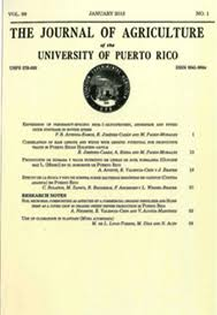Abstract
The daily weight gain (DWG) of growing Sudan-type hair sheep was evaluated using 1,090 records taken over two years at three farms located in the dry tropics of the Colombian Caribbean region. On each farm, the type of birth (single or multiple) and the sex of lambs were recorded. To determine DWG, 1,090 lambs were weighed weekly from birth to 240 days of age. The data were analyzed according to a completely randomized statistical design with factorial arrangement 3 (farms) x 2 (sex of the lamb) x 3 (type of delivery, single, double or triple). The Tukey test for the separation of means was used. The DWG was similar among the three farms averaging 112 g. A higher (P <0.05) DWG was observed in females than in males (115 versus 103 g), and as expected, the individual DWG of lambs from single calving (117 g) was higher (P <0.05) than twin (106 g) or triple (23 g). The highest DWG of ewe lambs than in males was observed on two of the three farms. The DWG was similar in males and females born from single births; however, in ewe lambs born from double births, DWG was higher (P <0.05) than in males, and the opposite was observed in triple deliveries where DWG was 32 g higher (P <0.05) in males than in females. In summary, DWG of Sudan hair sheep in the Caribbean region of Colombia is good given its extensive sheep raising system. The DWG was similar among farms but differed between the sex of the lamb and the type of parturition.

